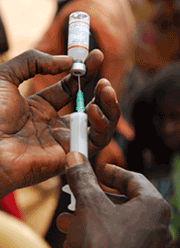Vaccine introduction strategy
Two-pronged approach includes mass vaccination and integration into existing programs
Introducing the newly developed vaccine, making sure all at-risk children are protected, is our next big challenge. |
Our introduction strategy is two-pronged: mass-vaccinate to gain immediate benefits on a public health level and then integrate the vaccine into routine childhood vaccination programs.
Mass immunization campaigns
Comprehensive mass immunization campaigns of 1- to 29-year olds with a single dose of MenAfriVac are a cornerstone of the meningococcal A conjugate vaccine introduction plan. This strategy aims to strongly and immediately reduce bacterial carriage and transmission and thereby rapidly reduce disease-related morbidity and mortality rates. Because large population groups will be immunized in a short period of time, the public health benefits of immunization should be rapidly visible and considerable. If these mass campaigns are not conducted, the populations will not be protected against epidemics.
Protection of birth cohorts
After mass vaccination campaigns have been conducted among 1- to 29-year olds, the main challenge will be protecting birth cohorts throughout infancy. The strategy used will depend on the results obtained in the clinical studies in infants and toddlers as well as on Expanded Programme on Immunization (EPI) coverage rates in the involved countries.
- In countries where EPI coverage is high (>80% DTP3), MenAfriVac could be integrated into the existing EPI calendar. Two schedules are being evaluated: a single dose during the second year of life or two doses at 14 weeks and 9 or 12 months of age (concomitantly with measles or yellow fever).
- In countries where EPI coverage is low (<60% DTP3), follow-up single-dose campaigns targeting children aged 1 to 4 years could be organized every 5 years.
The plan is consistent with the WHO Global Immunization Strategy and Vision and will use the comprehensive multiyear planning process—a 3- to 5-year plan that outlines a country's immunization priorities, how they plan to integrate immunization activities, what the costs will be, what new vaccines they are planning to introduce, and how they will expand coverage. This work will require advocacy and a major public health commitment on the part of meningitis belt countries and donor agencies.
The introduction of the new vaccine is a giant step toward achieving elimination of epidemic meningitis as a public health problem in sub-Saharan Africa.
Photo: UNICEF/Jon Shadid.

